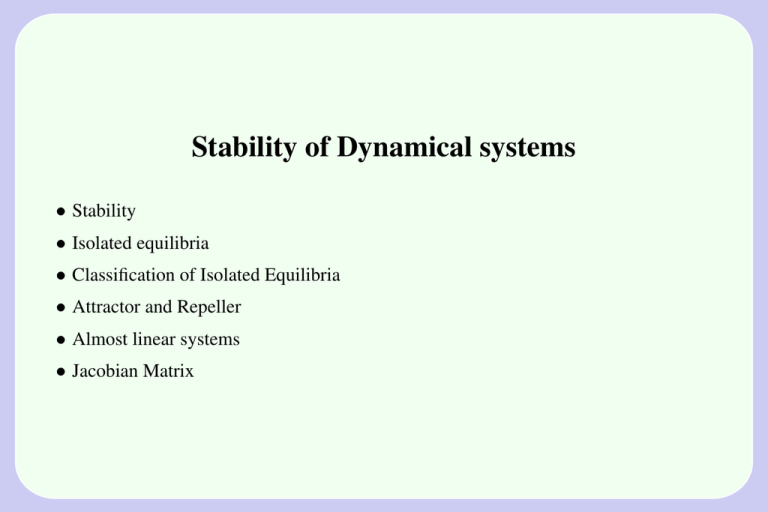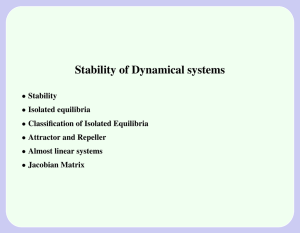Stability of Dynamical systems •
advertisement

Stability of Dynamical systems • Stability • Isolated equilibria • Classification of Isolated Equilibria • Attractor and Repeller • Almost linear systems • Jacobian Matrix Stability 0 Consider an autonomous system ~ u (t) = ~f (~ u(t)) with ~f continuously differentiable in a region D in the plane. Stable equilibrium. An equilibrium point ~ u0 in D is said to be stable provided for each > 0 there corresponds δ > 0 such that (a) and (b) hold: (a) Given ~ u(0) in D with k~ u(0) − ~ u0k < δ , then ~ u(t) exists on 0 ≤ t < ∞. (b) Inequality k~ u(t) − ~ u0k < holds for 0 ≤ t < ∞. Unstable equilibrium. The equilibrium point ~ u0 is called unstable provided it is not stable, which means (a) or (b) fails (or both). Asymptotically stable equilibrium. The equilibrium point ~ u0 is said to be asymptotically stable provided (a) and (b) hold (it is stable), and additionally (c) limt→∞ k~ u(t) − ~ u0k = 0 for k~ u(0) − ~ u0k < δ . Isolated equilibria An autonomous system is said to have an isolated equilibrium at ~ u=~ u0 provided ~ u0 is the only constant solution of the system in |~ u−~ u0| < r , for r > 0 sufficiently small. Theorem 1 (Isolated Equilibrium) The following are equivalent for a constant planar system ~ u0(t) = A~ u(t): 1. The system has an isolated equilibrium at ~ u = ~0. 2. det(A) 6= 0. 3. The roots λ1 , λ2 of det(A − λI) = 0 satisfy λ1 λ2 6= 0. Proof: The expansion det(A − λI) = (λ1 − λ)(λ2 − λ) = λ2 − (λ1 + λ2 )λ + λ1 λ2 shows that det(A) = λ1 λ2 . Hence 2 ≡ 3. We prove now 1 ≡ 2. If det(A) = 0, then A~ u = ~0 has infinitely many solutions ~ u on a ~ ~ ~ line through 0, therefore ~u = 0 is not an isolated equilibrium. If det(A) 6= 0, then A~u = 0 has exactly one solution ~u = ~0, so the system has an isolated equilibrium at ~u = ~0. Classification of Isolated Equilibria For linear equations ~ u0(t) = A~ u(t), we explain the phase portrait classifications saddle, node, spiral, center near an isolated equilibrium point ~ u = ~0, and how to detect these classifications, when they occur. Symbols λ1 , λ2 are the roots of det(A − λI) = 0. Atoms corresponding to roots λ1 , λ2 happen to classify the phase portrait as well as its stability. A shortcut will be explained to determine a classification, based only on the atoms. Figure 1. Saddle Figure 2. Improper node Figure 3. Proper node Figure 4. Spiral Figure 5. Center Saddle λ1, λ2 real, λ1λ2 < 0 A saddle has solution formula ~ u(t) = eλ1t~c1 + eλ2t~c2, ~c1 = A − λ2 I λ1 − λ2 ~ u(0), ~c2 = A − λ1I λ2 − λ1 ~ u(0). The phase portrait shows two lines through the origin which are tangents at t = ±∞ for all orbits. A saddle is unstable at t = ∞ and t = −∞, due to the limits of the atoms er1 t , er2 t at t = ±∞. Node λ1, λ2 real, λ1λ2 > 0 Case λ1 = λ2 . An improper node has solution formula ~ u(t) = eλ1t ~c1 + teλ1t ~c2, ~c1 = ~ u(0), ~c2 = (A − λ1I)~ u(0). An improper node is further classified as a degenerate node (~c2 = 6 ~0) or a star node (~c2 = ~0). Discussed below is subcase λ1 = λ2 < 0. For subcase λ1 = λ2 > 0, replace ∞ by −∞. degenerate node star node A phase portrait has all trajectories tangent at t = ∞ to direction ~c2 . A phase portrait consists of trajectories ~ u(t) = eλ1t~c1, a straight line, with limit ~0 at t = ∞. Vector ~c1 can be any direction. Node λ1, λ2 real, λ1λ2 > 0 Case λ1 6= λ2 . A proper node is any node that is not improper. Its solution formula is ~ u(t) = eλ1t~c1 + eλ2t~c2, ~c1 = A − λ2 I λ1 − λ2 ~ u(0), ~c2 = A − λ1I λ2 − λ1 ~ u(0). • A trajectory near a proper node satisfies, for some direction ~ v, 0 0 limt→ω ~ u (t)/|~ u (t)| = ~ v, for either ω = ∞ or ω = −∞. Briefly, ~ u(t) is tangent to ~ v at t = ω . • To each direction ~ v corresponds some ~ u(t) tangent to ~ v. Spiral λ1 = λ2 = a + ib complex, a 6= 0, b > 0. A spiral has solution formula ~ u(t) = eat cos(bt)~c1 + eat sin(bt)~c2, ~c1 = ~ u(0), ~c2 = A − aI b ~ u(0). All solutions are bounded harmonic oscillations of natural frequency b times an exponential amplitude which grows if a > 0 and decays if a < 0. An orbit in the phase plane spirals out if a > 0 and spirals in if a < 0. Center λ1 = λ2 = a + ib complex, a = 0, b > 0 A center has solution formula ~ u(t) = cos(bt)~c1 + sin(bt)~c2, 1 ~c1 = ~ u(0), ~c2 = A~ u(0). b All solutions are bounded harmonic oscillations of natural frequency b. Orbits in the phase plane are periodic closed curves of period 2π/b which encircle the origin. Attractor and Repeller • An equilibrium point is called an attractor provided solutions starting nearby limit to the point as t → ∞. • A repeller is an equilibrium point such that solutions starting nearby limit to the point as t → −∞. • Terms like attracting node and repelling spiral are defined analogously. Almost linear systems A nonlinear planar autonomous system ~ u0(t) = ~f (~ u(t)) is called almost linear at equilibrium point ~ u=~ u0 if there is a 2 × 2 matrix A and a vector function ~g such that ~f (~ u) = A(~ u−~ u0) + ~g(~ u), k~g(~ u)k lim = 0. k~ u−~ u0 k→0 k~ u−~ u0k The function ~ g has the same smoothness as ~f . We investigate the possibility that a local phase diagram at ~ u = ~ u0 for the nonlinear system ~ u0(t) = ~f (~ u(t)) is graphically identical to the one for the linear system ~ y0(t) = A~ y(t) at ~ y = 0. Jacobian Matrix Almost linear system results will apply to all isolated equilibria of ~ u0(t) = ~f (~ u(t)). This is accomplished by expanding f in a Taylor series about each equilibrium point, which implies that the ideas are applicable to different choices of A and g , depending upon which equilibrium point ~ u0 was considered. Define the Jacobian matrix of ~f at equilibrium point ~ u0 by the formula J = aug ∂1 ~f (~ u0), ∂2 ~f (~ u0 ) . Taylor’s theorem for functions of two variables says that ~f (~ u) = J (~ u−~ u0) + ~g(~ u) where ~ g(~ u)/k~ u−~ u0k → 0 as k~ u−~ u0k → 0. Therefore, for ~f continuously differentiable, we may always take A = J to obtain from the almost linear system ~ u0(t) = ~f (~ u(t)) its linearization y 0(t) = A~ y(t).







